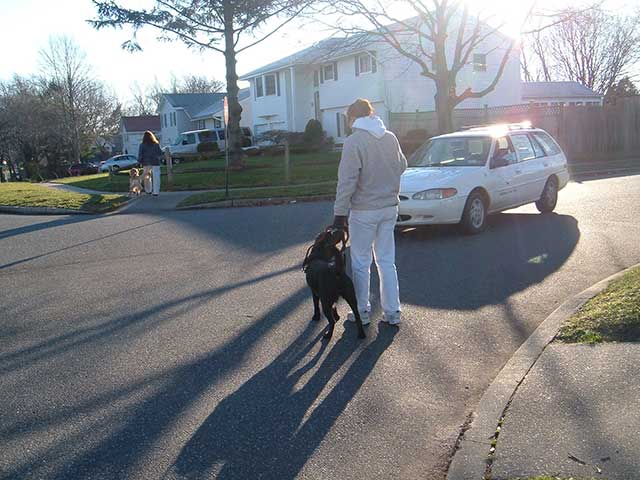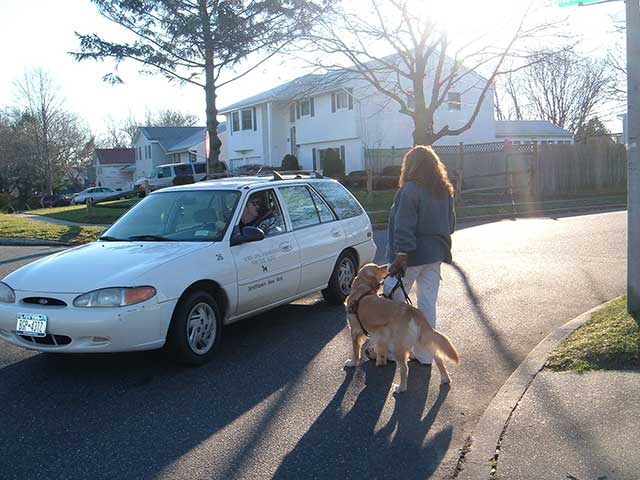Intelligent Disobedience: Just Say No


Usually, guide dogs are models of obedience, following commands as the team maneuvers along busy streets, crowded malls, or secluded forests. Guide dogs must also know when to refuse a command, no matter what their masters say, in order to preserve the safety of the team. Guide-dog trainers call this "intelligent disobedience." Crucial to guide work, it is a fusion of learned skills and honed instincts that reveal the vigilance and subtle thinking of successful guide dogs.
Cathy Burke, a trainer for Fidelco Guide Dog Foundation, and a social worker with the Massachusetts Commission for the Blind, says, "With intelligent disobedience, we teach dogs to be responsible for another being's existence. It's amazing when you think of doing that in animal training." Blind from birth, Ms. Burke not only trains guide dogs, but relies on one every day.
Teaching Humans to Listen
Intelligent disobedience goes both ways. The dog must know when to disobey, but the human must learn to recognize when the dog is intelligently disobeying, and heed the "advice." This understanding takes time to develop, as illustrated in the story of Alex, who went to work each day with his guide dog, riding the elevator to and from his office. One day, at the end of work, the elevator was out of service. There was a sign redirecting people, but Alex could not see it. His guide dog, however, was able to read the situation and refused to walk into the open elevator shaft.
Alex was still new at working with a guide and could not understand why the dog refused to obey, even after the "forward" command has been issued loudly two times. Frustrated, Alex decided to go forward. He learned about intelligent disobedience the hard way, falling several feet and injuring himself, while his guide dog stood quietly at the edge of the open shaft. Alex soon recovered and returned to his daily routine, albeit with greater appreciation for the messages his guide dog gives him.
Learning to Disobey
Preparing a dog for guide work departs from most other forms of training in the amount of independence the dog not only maintains, but develops. Maria Nuzzi, a trainer with Guide Dog Foundation for the Blind in Smithtown, NY, says, "A dog who simply follows commands is an ineffective guide. Disobeying, in the right situations, makes a guide dog much more valuable."
According to Lori Brown, a training supervisor at Guide Dogs for the Blind, in San Rafael, CA, "The human is still the alpha, but the dog learns when, for safety reasons, it is not just OK, but vital, to disobey and think on their own."
The trick is encouraging the independence and self-confidence to disobey, with the knowledge of when it is necessary. Ms. Brown says, "If the dog gets too much control, there's a problem because the dog is running the show. And yet, the dogs are still dogs, and must maintain their native curiosity. The dog might like to go sniffing after a cat, but if the human says to move forward, the dog gets back on line. But if the dog is stopping because of something unsafe, they should refuse to move no matter what the human says or does."
Intelligent disobedience is developed during a four-month training period, in which guide dogs acquire all their skills and both the dog and the person connect at a non-verbal level. Ian Ashworth, a trainer for Guide Dog Foundation for the Blind, says that from a young age guide dogs are exposed to a series of situations, gradually increasing in complexity. "We start off just having the dogs avoid obstacles like lampposts or mailboxes. You teach them to stop at curb sides, at intersections, to walk around other people."
The initial training is done in quiet places. Then the trainers take the dog into a small downtown zone, with more unpredictable distractions. Next, they head for metropolitan settings. As Mr. Ashworth explains, "Once the basic training is tucked away, we might say, 'OK, how would you deal with Manhattan?' The dog learns to make decisions and find his way through with little help from the trainer."
By now, the dog can navigate safely through a busy life, aware of dangers coming from all directions, able to adjust to constant changes in the environment. The trainers then bring the human, often referred to as "the student," into the team. The student holds the dog's lead and gains a feel for the dog's unique carriage, reading what the dog is saying as much as the dog reads what the person needs. "The student learns to respond to all the dog's stops and turns," Mr. Ashworth explains. "It takes many months, which is why people come for training."
Ms. Nuzzi adds, "The biggest thing at this stage is for students to trust when the dog is trying to tell them something." Most blind individuals have some sight, and early in training they instinctively use it to second-guess the dog. Ms. Nuzzi says this can prevent the person from learning to trust the dog. One solution is to have the team practice in the dark. "When they go out for night walks, you can see the person bonding and trusting the dog more quickly."
Starting at about the eighth week of training, the dog learns not only to follow commands, but also to be cognizant of the person's unique characteristics, such as body size, and the pace and manner in which the person moves. If the team encounters a situation where the dog could safely pass, but the person cannot, the dog learns to intelligently disobey. "The guide dog might see a gap that it can fit through, but it's too tight for the person," Mr. Ashworth explains. "But with intelligent disobedience, you teach the dog to know that it must not pass through the gap unless it is the width of itself and the human. You teach the dog to imagine that he's double his actual size."
Guide dogs learn that beings with two legs are not quite as agile as ones with four. Ms. Brown says that guide dogs are taught to stop at all curbs, even though they can jump down or up without a problem. "We reinforce them for stopping at a curb, and they learn that stopping at a curb is really good." Once they have mastered curbs, Ms. Brown says, the dog is taught to generalize for all drops and steps.
There is underpass training, where a horizontal bar is set up at various heights across the training path. The dog is taught not to walk beneath the bar, understanding that such obstacles may be high enough for a dog, but would hit a person on the head.
The dog is taught to stop for holes in the ground, objects lying in the path, puddles, or uneven surfaces. These are all things a dog can easily navigate, but they present serious problems for a blind person. The guide dog learns to recognize dangers, but more importantly, refuses to do what is natural – jump up or down, circle around, or step over an obstacle – even if the human commands her to do it.
Lifetime of Learning
Rote training, while necessary for guide work, cannot cover all situations a guide team will encounter in the 12 years they spend together. After the dog and person graduate from guide school and head out into the real world, a lot of new learning takes place.
Ms. Brown says that the dogs do not simply memorize situations from training. They get to know their masters and fine tune their intelligent disobedience decisions. Offering an example she witnessed herself, Ms. Brown recalls an evening at a restaurant with a friend, who came with her guide dog of many years. After dinner, they went into the parking lot to get into Ms. Brown's car. "The dog seemed to be going right passed the car," Ms. Brown explains. "I was about to say something when I realized that the dog had changed direction and was bringing her around to the passenger side." When Ms. Brown took a closer look, she saw that another car was parked too close to hers – enough space for the dog to pass through but not enough for the person. Effortlessly, the dog read the situation and found a safer passage. The dog was not only intelligently disobeying, but did it in such a way that the owner hardly realized the change in direction. Even after years of working with guide dogs, Ms. Brown said this amazed her. "The dog had only been in my car once, but she figured out which door to use and the best way to get to it. That would never happen unless we developed the dog's initiative and gave her the freedom to think on her own."
Ms. Burke shares a first-hand story that illustrates how guide dogs handle novel situations. One evening, her German Shepherd guide, Othello, was extremely agitated. "Suddenly, he ran into the bedroom, jumped up onto the crib, and tried to pick my baby up in his mouth," she says. Othello would not take no for an answer, repeatedly trying to grab the baby. Ten minutes later, there was a knock at their apartment door. "Fireman were there, and the whole hallway was full of smoke." Othello had understood the danger. To save the baby, he chose to disobey Ms. Burke's commands to lie down.
Getting to Know Each Other
Over time, guide dogs become so attuned that they detect their master's physical changes, and react accordingly, intelligently disobeying in new kinds of situations. Ms. Burke says that when she was pregnant her guide dog learned not to go through narrower passages. "Both times I was pregnant, my dog had an uncanny knowledge of what to do," she says. "He was even more cautious. He moved differently, so I wouldn't bang into things."
Ms. Brown fits intelligent disobedience into the entire human-canine relationship, one that deepens over time. "We check in with the teams each year. It's amazing what people report, how much they can feel through the harness. They can sense every little way the dog's shoulders or head move, even how the dog is breathing." Likewise, the dog is aware of the person's slightest quirks. Many times, people do not even notice unless it is pointed out to them.
Ms. Brown is proud that her training gives dogs opportunities to do engaging and helpful work, and offers people a chance to connect with dogs for better lives. "People who choose to get a guide dog are dog lovers. That's why they get a dog instead of a cane. I'm a dog lover, but to have a dog that is not only a pet and a companion, but also someone you rely on for your safety, that's a whole different level."
Ms. Burke understands, as both a trainer and as someone who relies on guide dogs. "I've been blind all my life," she says. "When I was a child, I never learned how to use a cane. I had no mobility. I was always hitting things and falling down. In high school, I got to work with a guide dog, and it was like someone let me out of a cage full of stress and turmoil. Even after 26 years, I'm grateful every single day that I'm able to move like a sighted person, and be dignified in the way I travel."
